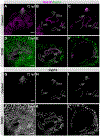Exposure to the persistent organic pollutant 2,3,7,8-tetrachlorodibenzo-p-dioxin (TCDD, dioxin) disrupts development of the zebrafish inner ear
- PMID: 37086653
- PMCID: PMC10519160
- DOI: 10.1016/j.aquatox.2023.106539
Exposure to the persistent organic pollutant 2,3,7,8-tetrachlorodibenzo-p-dioxin (TCDD, dioxin) disrupts development of the zebrafish inner ear
Abstract
Dioxins are a class of highly toxic and persistent environmental pollutants that have been shown through epidemiological and laboratory-based studies to act as developmental teratogens. 2,3,7,8-tetrachlorodibenzo-p-dioxin (TCDD), the most potent dioxin congener, has a high affinity for the aryl hydrocarbon receptor (AHR), a ligand activated transcription factor. TCDD-induced AHR activation during development impairs nervous system, cardiac, and craniofacial development. Despite the robust phenotypes previously reported, the characterization of developmental malformations and our understanding of the molecular targets mediating TCDD-induced developmental toxicity remains limited. In zebrafish, TCDD-induced craniofacial malformations are produced, in part, by the downregulation of SRY-box transcription factor 9b (sox9b), a member of the SoxE gene family. sox9b, along with fellow SoxE gene family members sox9a and sox10, have important functions in the development of the otic placode, the otic vesicle, and, ultimately, the inner ear. Given that sox9b is a known target of TCDD and that transcriptional interactions exist among SoxE genes, we asked whether TCDD exposure impaired the development of the zebrafish auditory system, specifically the otic vesicle, which gives rise to the sensory components of the inner ear. Using immunohistochemistry, in vivo confocal imaging, and time-lapse microscopy, we assessed the impact of TCDD exposure on zebrafish otic vesicle development. We found exposure resulted in structural deficits, including incomplete pillar fusion and altered pillar topography, leading to defective semicircular canal development. The observed structural deficits were accompanied by reduced collagen type II expression in the ear. Together, our findings reveal the otic vesicle as a novel target of TCDD-induced toxicity, suggest that the function of multiple SoxE genes may be affected by TCDD exposure, and provide insight into how environmental contaminants contribute to congenital malformations.
Keywords: Dioxin; Ear; Otic vesicle; Semicircular canal; TCDD; Zebrafish.
Copyright © 2023 Elsevier B.V. All rights reserved.
Conflict of interest statement
Declaration of Competing Interest The authors declare no conflicts of interest. This study was completed without any financial affiliations that could be interpreted as a potential conflict of interest.
Figures







Update of
-
Exposure to the persistent organic pollutant 2,3,7,8-Tetrachlorodibenzo-p-dioxin (TCDD, dioxin) disrupts development of the zebrafish inner ear.bioRxiv [Preprint]. 2023 Mar 15:2023.03.14.532434. doi: 10.1101/2023.03.14.532434. bioRxiv. 2023. Update in: Aquat Toxicol. 2023 Jun;259:106539. doi: 10.1016/j.aquatox.2023.106539. PMID: 36993549 Free PMC article. Updated. Preprint.
References
-
- Abbas L, Whitfield TT, 2010. The zebrafish inner ear. Fish Physiol. 29 (C), 123–171. 10.1016/S1546-5098(10)02904-3. - DOI
MeSH terms
Substances
Grants and funding
LinkOut - more resources
Full Text Sources

